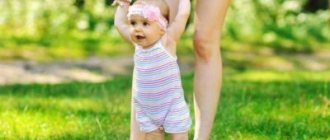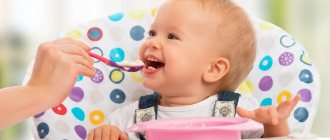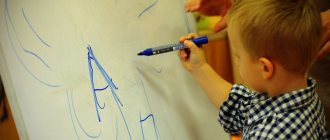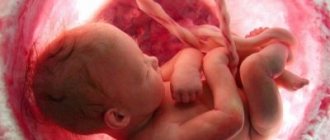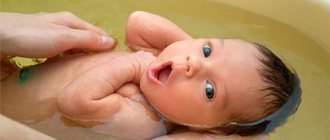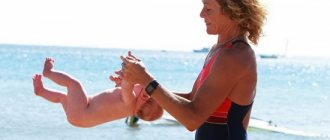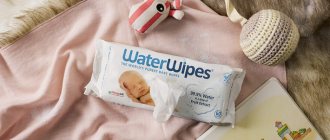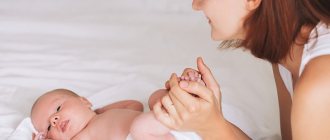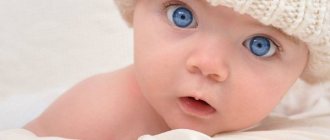Good afternoon, many will be interested in understanding the health of their loved ones, and I will tell you my experience, and we will talk about clothing sizes for a newborn baby. Most likely, some details may differ, as was the case with you. Please note that you should always consult with highly specialized specialists and not self-medicate. Naturally, you can quickly find the answer to the simplest questions and diagnose yourself. Write your questions/suggestions in the comments, and together we will improve and supplement the quality of the material provided.
Table of clothing sizes for newborns by month and height
| Age | Height (cm) | Hip circumference (cm) | Waist(cm) | Chest (cm) | Size |
| 0 months | up to 50 | 42-44 | 40-43 | 40-43 | 50 |
| 0-1.5 months | 51-56 | 44-46 | 42-45 | 42-45 | 56 |
| 1.5-3 months. | 57-62 | 46-48 | 44-47 | 44-47 | 62 |
| 3-6 months | 63-68 | 48-50 | 46-48 | 46-49 | 68 |
| 6-9 months | 69-74 | 50-52 | 47-50 | 48-51 | 74 |
| 9-12 months | 75-80 | 52-54 | 49-51 | 50-53 | 80 |
| 1-1.5 years | 81-86 | 54-56 | 50-52 | 51-55 | 86 |
| 2 years | 87-92 | 56-58 | 51-53 | 52-56 | 92 |
It is better to choose clothes for a newborn based on height. This way, you will choose the most suitable clothes that will not need to be exchanged in the store. You can focus on the age of a newborn by months, if only the child grows with standard parameters.
Child growth charts by month
To determine the timeliness of the physiological development of the baby, special tables and lists of individual indicators, in particular growth, are used. Table values for boys in the first year of life (first indicator) and girls (second indicator):
- at birth - 50-54 cm; 49.5-53.5 cm;
- 1 month – 54-58 cm; 53.5-56.5 cm;
- 2 months – 57-61 cm; 56-60 cm;
- 3 months – 61-64 cm; 60-62 cm;
- 4 months – 63-67 cm; 62-64 cm;
- 5 months – 66-68 cm; 64-66 cm;
- six months – 68-70 cm; 66-68 cm;
- 7 months –70-71.5 cm; 67-69 cm;
- 8 months – 71-73 cm; 68-70 cm;
- 9 months – 73-74 cm; 70-72 cm;
- 10 months – 74-76 cm; 72-74 cm;
- 11 months – 75-77 cm; 73.5-75 cm;
- 1 year – 76-79 cm; 74.5-76 cm.
These are approximate indicators that pediatricians rely on during monthly examinations. By the way, there are several options for growth tables by month, but they all have almost the same structure, differing only slightly from each other.
Sizes of tights for newborns
| Foot length(cm) | Age | Size |
| 7 | 0-1.5 months | 50-56 |
| 8 | 0-3 months | 56-62 |
| 9 | 1.5-6 months. | 62-68 |
| 9-10 | 3-9 months | 68-74 |
| 11-12 | 6-12 months | 74-80 |
| 12-13 | 9-18 months | 80-86 |
| 13-14 | 1-2 years | 86-92 |
The size of tights for newborns can be easily determined by age or foot size. Different manufacturers use different sizing charts. We combined the two most popular ones and recorded them in a table.
Sizes of rompers for newborns
Most mothers first encounter the Russian size chart when choosing rompers, panties, and T-shirts. The Russian size chart for children's clothing differs from the European one not only in standard metric indicators, but also in the main size. If you see sizes 18, 20, 22 on clothes made in Russia, then this is a Russian size chart. You will find a table with the Russian size chart for newborn clothing here, just below.
We would like to draw your attention to the fact that the Russian size chart is aimed at children who are not very well-fed. Today, most newborns are larger than 30-50 years ago, when GOST was created. Therefore, when choosing a size according to the table below, pay attention not only to height, but also to the chest circumference of your child. First, based on the height of the newborn, find the appropriate size in the table, then compare the chest circumference in the table and that of the baby. If your newborn's chest circumference is smaller than in the chart, choose a size that matches their height. If the newborn's chest circumference is larger than indicated in the table, take a larger size.
| Size | 18 | 20 | 22 | 24 | 26 |
| Height in cm | 50-56 | 62-68 | 74 | 80 | 86-92 |
| Chest circumference in cm | 40 | 44 | 44 | 48 | 52 |
| Waist circumference in cm | 40 | 44 | 45 | 48 | 52 |
| Hip circumference in cm | 42 | 46 | 50 | 54 | 56 |
| Approximate age | 0-1.5 months | 1.5-6 months. | 6-9 months | 9-12 months | 1-2 years |
Sock size chart for newborns by month
| Age | Foot length(cm) | Russian size | Size |
| 0-1 month | up to 6.4 | 10 | 6 |
| 0-1.5 months | 6,5-7,4 | 7 | |
| 0-3 months | 7,5-8,4 | 8 | |
| 1.5-3 months. | 8,5-9,4 | 9 | |
| 3-6 months | 9,5-10,4 | 10 | |
| 6-9 months | 10,5-11,4 | 12 | 11 |
| 9-12 months | 11,5-12,4 | 12 | |
| 1-1.5 years | 12,5-13,4 | 14 | 13 |
| 1.5-2 years | 13,5-14,4 | 14 |
It is very important to choose the right size of socks for newborns . Pay attention to the material, manufacturer and size. It is better to buy socks made from natural materials so that the newborn’s skin can breathe. At the same time, socks should keep you warm and not press on.
The length of the foot must be measured on a piece of paper. Take a blank A4 sheet and place both of your child’s feet on it. Measure the length from big toe to heel. Select the size that turns out to be larger and compare the result with the table.
How does a leg grow over the months?
Despite the fact that each newborn may have its own characteristics of body development, in pediatrics there is a kind of table that indicates the normal length of a child’s foot by month of life.
If you measure a child’s foot by month from birth to one year, the parameters will be as follows: up to 3 months – 9.5 cm; from 3 to 6 months – 10.5 cm; from 6 to 12 months – 11.7 cm.
Children aged one and three years will have the following foot parameters: from 12 to 18 months – 12.5 cm;
From 18 to 24 months – 13.4 cm; from 24 months to 36 – 14.7 cm. Three-year-old child – 15.2 cm.
When a child reaches the age of 4 years, the leg will be approximately 17.3 cm in length, while for a five year old it will be 18.4 cm.
Sizes of baby vests for newborns
Baby onesies have always been essential clothing for babies. They are practical and warm, and they are also easy to put on a capricious child. However, choosing baby undershirts is not an easy task. You need to decide on the type of fastener, sleeve length, type of seams (external or internal). When choosing undershirts for a newborn baby, it is better to choose ones with an internal seam. A baby's soft skin can be damaged by tight stitches during movements.
The sizes of the vests are chosen solely according to the baby’s height. They can be free in width, thereby giving the child space to move. So, to measure the growth of a newborn, you need to place him on a flat surface. Let the baby calm down and relax. Hold this position for a few seconds and take several measurements. Select the average and compare your findings with the table below. You can also see the height measured by the doctor at the appointment. However, be careful, the baby will outgrow its size in 2-3 months.
Different manufacturers of vests use their own sizes. To make it easier to make a choice, we have compiled a table of average values for newborns and babies under 2 years old. All European manufacturers use almost the same size charts, so the results will vary minimally. Select the size of the vest for your child below.
Baby onesies have always been essential clothing for babies. They are practical and warm, and they are also easy to put on a capricious child. However, choosing baby undershirts is not an easy task. You need to decide on the type of fastener, sleeve length, type of seams (external or internal). When choosing undershirts for a newborn baby, it is better to choose ones with an internal seam. A baby's soft skin can be damaged by tight stitches during movements.
Table of standard sizes of newborns by month to year
This table will make it easier for you to navigate. It is especially useful if you order things for your boy or girl online.
| Age (in months) | Height (cm) | Chest circumference during inspiration | Russian size | European size | US size |
| 56 | 36 | 18 | 56 | 0/3 | |
| 3 | 62 | 40 | 20 | 62 | 0/6 |
| 6 | 68 | 44 | 20 | 68 | 0/6 |
| 9 | 74 | 48 | 22 | 74 | 6/9 |
| 12 | 80 | 52 | 24 | 80 | S/M |
Choosing yarn
In order for the yarn to be ideal for children's knitted shoes, you need to pay special attention to its selection.
For such a product, you need to purchase one that is intended for children's things, is hypoallergenic, and therefore undergoes special health safety and quality control.
As a rule, manufacturers mark yarn for children with special marks or call them characteristic names, for example, “Krokha”, “Baby”, “Baby”, “Fidget”, etc.
If the search for such threads was unsuccessful for you, then choose from the available assortment, paying attention to the following characteristics:
- naturalness;
- thickness;
- color.
And remember that babies at this age really love to taste their feet, so they will certainly want to “feast” on booties. Therefore, buy high-quality, expensive yarn from a trusted manufacturer.
Naturalness
It is necessary to give preference to threads, a larger percentage of which (60-80%) are natural fibers, such as wool or cotton. It is these materials that are able to absorb moisture and allow air to pass freely, which will allow small legs to develop normally and the skin to breathe.
We choose suitable infant formulas: from what age and how to breed “Hipp Combiotic-3”, “Humana Expert-1”, “Baby Premium 1”, “Nutrilak-1”, “Malyutka-3”, “Agusha-2”, “ NAN Optipro", "Nutrilon Premium-1", "Nestozhen-4", "Similak-2", "Frisolak 1", "Nutrilon Premium-2", "Malyutka 1", "Malyutka-4", "Similac Premium 1" ", "Similac 1", "Nestozhen-2", "Similac-3".
Remember - synthetics do not absorb moisture, which means that your baby may have constantly wet feet. In addition, it is electrified, and air does not pass through it well.
Important! Products made from natural threads should be knitted a size larger, as they will shrink after the first wash.
.
Thread thickness
The thickness of the thread will depend on what season you are knitting shoes for. For the autumn-winter period, thicker woolen threads are needed. For spring and summer - thin, cotton ones.
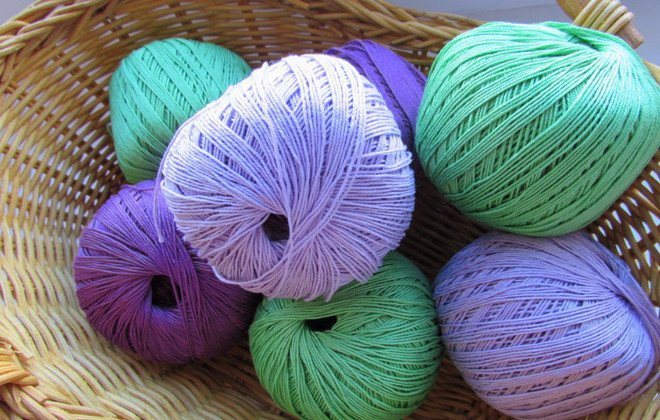
However, even for winter you need to choose yarn that is pleasant to the touch, not coarse and not too thick. Otherwise, the booties will cause discomfort to the baby, injure him, or rub him, and he will simply refuse to wear them.
Color selection
When choosing the color of yarn, you should pay attention to calm, natural tones, since to obtain bright colors, strong dyes will most likely be used, which can dye the delicate skin on children's feet.
If you like variegated shades, then you can take some pastel as the main color and make the finish bright.
You can also listen to the advice of psychologists who say that children under the age of one year most like things in three colors: orange, green and yellow.
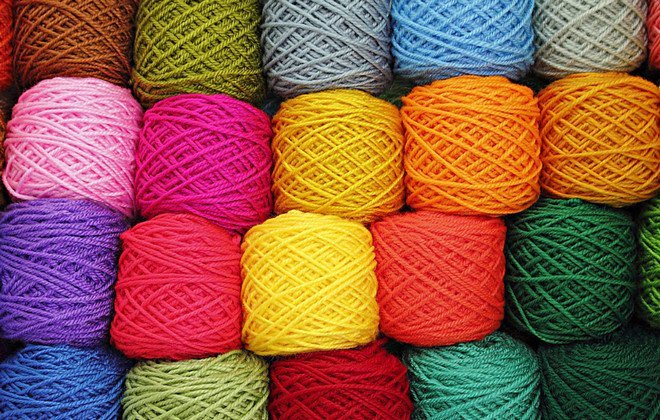
If you are an adherent of a clear gradation of colors by gender, then choose a color depending on who you are knitting booties for - for a boy or for a girl. Traditional “girly” colors are pink, purple, and crimson. For boys, blue, light blue, and gray are suitable.
Did you know? The world record for knitting speed was set by a resident of the Netherlands, Miriam Tegels. She knits 118 stitches in a minute.
Features of measurements
There is a significant difference between the sizing charts of Russian and foreign manufacturers. Russian clothing sizes for newborns by month are mainly based on chest volume, which is divided in half. The resulting number is the size written on the tag. Measurements must be taken strictly while inhaling, and the measuring tape at this time is located under the baby’s armpits. In addition, you need to measure the height of the baby from the top of the head to the toes. If you are interested in how to determine the size of a newborn before birth in order to buy clothes in advance, then take the number 36 as a basis - this is the average circumference of the baby’s chest at birth. That is, the appropriate size would be 18 cm.
As for European manufacturers, they often use a different system for calculating standard sizes of a newborn. When sewing, they focus mainly on the growth of the baby. This is the size indicated on the tag. You need to buy something that says the height is slightly larger than the actual height. For example, for a child 58 cm tall, clothes with label 62 are suitable. Less commonly, “S” or “M” markings are used for children’s clothing.
As in adults, the main parameter here is the length of the foot.
How to choose clothes for children from foreign manufacturers
In addition to domestic products, there is a lot of Chinese and American clothing on the market; the sizing charts for such products differ from Russian standards.
Foreign clothing sizes for newborns by month - table
| Age (months) | America | China |
| newborns | 0/3 | |
| 3 | 0/6 | 3 |
| 6 | 0/6 | 6 |
| 9 | 6/9 | 9 |
| 12 | S/M | 12 |
How to choose hats and socks
Babies require thin, demi-season and warm hats; to determine the correct size, you just need to measure the head circumference.
- 0-3 months (35-40);
- 3-6 (44-46);
- 6-9 (46-47);
- 9-12 (47).
Thin hats should be taken exactly in accordance with the circumference, warm ones - one size larger. Boys need larger sizes than girls.
To select socks, you need to measure the length of the foot, usually 8-9 cm, the optimal size of products for babies is 0, or 0-3, there may be a designation of 10 on Russian goods.
What do you need to buy for the maternity hospital?
We are sure that this list will help you not to forget anything and not to add unnecessary things:
- bodysuit;
- several cotton rompers and vests;
- light hats with ties;
- small blanket;
- envelope for discharge.
If the baby was born in winter, then the discharge kit differs significantly from the summer kit. Don’t forget to “warm” your baby before going outside for the first time.
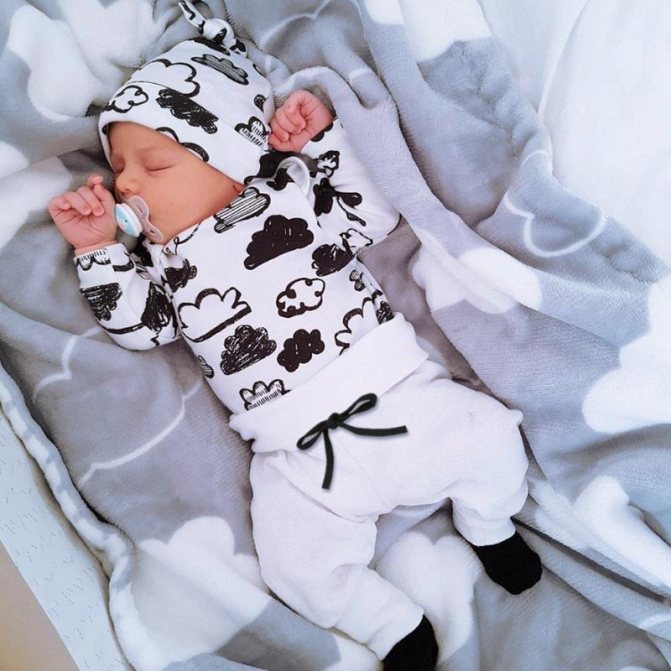
Good afternoon, dear readers.
Do you know what problem many expectant mothers have? You walk into a children's clothing store, and your eyes widen - everything is so beautiful, cute, you want to buy everything at once. Arguments that children grow quickly do not work for many, so today we will find out what sizes of clothes for newborns exist so that you can understand what you need to buy before the maternity hospital, and what you will need a little later.
Babies require thin, demi-season and warm hats; to determine the correct size, you just need to measure the head circumference.
Newborn growth rates
Normal height and weight of a newborn
Of course, the first measurements in a newborn’s life are taken immediately at the moment of his birth, and these numbers are recorded in the medical record. If the baby was born full-term (not earlier than 38 weeks), then the newborn’s height is considered normal: 45-55 cm, and weight – 3200 – 3500 kg. Although there are quite possible options here too. After all, each baby is purely individual, and its parameters largely depend on the height and weight of its parents. Of course, if mom and dad have a large physique, then their child is born a hero.
Immediately in the first days after birth, a newborn loses some of its weight - approximately 10%. This is completely normal and should not bother you. Now excess fluid is being removed from his body, and the baby has yet to learn how to suck mother’s milk. Therefore, if you want to measure the weight and height of the child at this time, do not rush to get upset. The newborn regains its original weight by the third week of its life, and after that it only begins to grow and get better. On average, a baby should gain 20 g of weight every day, and by the end of the first month of life, a newborn should add up to 4 cm. Increased growth and weight gain requires additional nutrition, therefore, approximately in the second week of his life, a newborn begins to actively and sucks greedily and demands to be fed more often than before.
Immediately after the baby is born, a neonatologist examines him and takes the first measurements of the head circumference, chest circumference, height and weight of the newborn. These measurements are needed in order to identify possible deviations from the norm in intrauterine development, based on the normal proportions of the body of newborns. Next, the treating pediatrician measures the circumference of the head and chest every month, and also measures the height and weight of the baby. Based on these and other indicators taken together, doctors draw a conclusion about the general health of the baby, and most importantly, about the presence of certain pathologies. Young mothers at home also measure the head circumference and height of the child to monitor his full development. But how to measure a newborn? Let's take a closer look at how and why you need to measure an infant.
Sizes at birth
Nature dictates that boys are born weighing about three and a half kilograms, and girls are 200-300 grams more graceful than boys. That is, the weight of newborn boys is 3.4-3.5 kg, and girls - 3.2-3.4 kg. The height of boys and girls depends on the family height of their parents. When measuring children at birth, obstetricians and nurses at the maternity hospital state a height of 45 to 58 cm.
At the birth of a baby, literally on the birthing chair, you are informed of the baby’s height and weight. The baby's parameters are also written on the tag, which is placed on the arm or leg next to the mother's last name. Now you know the first dimensions of your tomboy. Call your family and provide this information so that they can select everything they need for discharge from the maternity hospital.
If you are already a happy mother, it will be easier for you to decide on the size of your baby. But if you are just waiting for the birth of a little one, when buying things for your baby, be guided by the latest ultrasound readings, as well as your and your spouse’s sizes. The taller and larger the parents, the greater the height and weight of the newborn. Short parents almost always have small children. Accordingly, parents of average height and build will give birth to a baby with average statistics.
Sizes of a child up to one year: approximate values, rules for measuring height, tips
After the 30th week of pregnancy, the expectant mother begins to collect a “dowry” for the baby in the maternity hospital and for the first time after the baby is born.
The selection of children's clothing in the store is quite wide. And while there shouldn’t be any difficulties with the model range, a woman may get confused by the size of the items. The fact is that the products on the market are produced in different countries. In turn, domestic and European factories use different quantitative values when indicating clothing sizes. We will try to understand this in our article.
Let us dwell in detail on what sizes a child under one year old is, how to choose clothes for him and how to correctly measure his height yourself.
Parameters of a newborn baby
A baby is born with an average weight of 3400 g. At the same time, nature dictates that girls are usually born 200-300 g lighter, and boys 100-200 g heavier. At the same time, pediatricians note that recently large babies are increasingly being born, the parameters of which exceed the average data accepted by the World Health Organization.
But the height of a child depends entirely on how tall or short his parents are considered. The average value is 53 cm. Moreover, due to individual characteristics, deviations in one direction and the other by 5 cm are the norm.
Parents should monitor the baby’s parameters monthly. Knowing your baby’s size is necessary not only to make it easier to navigate the store and buy him beautiful clothes, but also to control the baby’s growth and development.
The planned dynamics will allow parents and pediatricians to draw correct conclusions about the baby’s condition. If there is a significant deviation from WHO standards, this may indicate some kind of developmental disorder.
In this case, additional examinations will be needed.
Normally, a child in the first half of life gains 20 g per day. The circumference of his chest and head increases every month by 10-15 mm, and his height by 20-25 mm. At the same time, the size of a child’s feet per year does not always correspond to the norms. Its value is more influenced by genetics. If the mother has a small foot, then one should not expect other indicators from the daughter.
How to measure height at home?
It should be noted right away that determining the exact length of a baby’s body is quite difficult. During the first time after birth, his muscles are in good shape, and it is almost impossible to straighten his body. That is why it is not so easy to determine how many centimeters a baby has grown compared to how much he has gained.
To measure height at home, you need to place a head rest. The wall of the room or the side of the changing table is suitable for this. The position of the feet should be perpendicular, as in a standing position.
Having made a mark in the place where the baby’s feet are located, the baby is removed. After this, height is determined using a measuring tape.
If your child has very strong muscle tone, then it is recommended to give him a relaxing bath before taking measurements.
Other baby measurements
In addition to height and weight, to control the physical development of the baby and choose clothes, you need to know other sizes of a child under one year old:
- Head circumference. Measurements are taken along the convex part of the back of the head and the line above the eyebrows. At birth, the head circumference is usually 35 cm, and by one year it increases to 46 cm.
- Chest circumference. Measured with a measuring tape at the highest points of the chest and back. If newborn children have an average chest circumference of 32 cm, then by three months this value increases by 6 cm. For a six-month-old baby, the same figure will be 45 cm, and for a nine-month-old - 50 cm. The chest circumference of an average child per year is 52 cm.
- Foot length. Measurements are taken with a ruler from the longest toe to the back of the heel. The length of the foot of a three-month-old baby is usually 7 cm, and by the age of one year the foot grows to 15 cm.
When going to the store, it is advisable to know all the sizes of the baby. Only in this case will it be possible to buy clothes and shoes for your child that will not only be elegant, but also comfortable.
Important nuances
When going to the store for children's clothing, you need to consider the following points:
- When choosing your favorite models for your baby, you should focus on his height and weight, and not on his age.
- A product of suitable length must be checked according to chest volume. This will avoid a situation where clothes hardly fit on a fat child and hang loose on a thin one.
- On the labels of most products, double indicators are written (for example, 3-6 or 6-9). When purchasing such clothing, you must focus on the last of these numbers.
- When choosing clothes for young children, there are no particular differences by gender regarding the size of the products. You can safely buy things of the same size for both boys and girls.
- Domestic and European manufacturers use different size grids when sewing clothes. Therefore, when going shopping, you need to find out in advance what size your child is. Until one year of age, it will be enough to know the baby’s height, body weight and head circumference. And at an older age, it is important to take into account all other parameters.
Clothing sizes for children under one year old
The range of products for kids is simply huge. In children's stores, the shelves are simply littered with all kinds of bodysuits, blouses, vests, little men, rompers and other clothes.
In order not to get confused when choosing the right product, you need to know the size of the child from 0 to one year. Depending on the manufacturer, the labeling of children's items may vary.
On clothes that are sewn in Russia, sizes are presented in even numbers.
| Table 1. Size chart for children's clothing, Russia | ||||
| Label size | 18 | 20 | 22 | 24 |
| Height, cm | 56 | 62-68 | 74 | 80 |
| Number of months | 0-2 | 2-6 | 6-9 | 12 |
| Bust volume, cm | 36-38 | 40-44 | 44 | 48 |
Having completed all the necessary measurements at home and having the child’s body parameters in hand, buying suitable clothes for him will not be difficult.
In addition to products from domestic factories, there are many interesting models from European manufacturers on the market. When choosing them, you should focus on the length of the child’s body, but also do not forget about its other parameters.
| Table 2. Clothing sizes for babies, Europe | ||||||
| Size | 50 | 56 | 62 | 68 | 74 | 80 |
| Body length, cm | up to 50 | 50-56 | 56-62 | 62-68 | 68-74 | 74-80 |
| Number of months | 0 | 0-1 | 1-3 | 3-6 | 3-9 | 9-12 |
| Chest circumference, cm | 40-42 | 42-45 | 44-47 | 46-49 | 48-51 | 50-53 |
Toddler shoe sizes
Foot length is measured using a ruler or centimeter. You can determine what shoe size your child has using the following table.
| Table 3. Russian shoe sizes for children | |||
| Size chart | 11 | 12 | 13 |
| Foot, cm | 10,5-11,5 | 11,5-12,5 | 12,5-13,5 |
| Age, months | until 9 | up to 12 | before 18 |
Based on the data in the table, it is easy to guess what the child’s foot size is per year. For a baby of average build, this is size 12, and the foot length is approximately 12 cm.
Headwear sizes
When choosing a hat for your baby, it is not enough to know his height and weight. Each child has its own pace of development. That is why when choosing a headdress for a baby, it is important to know the circumference of his head.
First, boys and girls develop differently. Typically, a girl's head circumference is 1-2 cm smaller.
And secondly, the head of a large three-month-old baby may be larger than that of a small six-month-old baby.
Products are most often marked with a double symbol, for example, 40-42 cm. This means that the hat is suitable for a baby whose head circumference fits into these values. Everything is very simple.
As for the circumference of a child’s head at 1 year old, its size is usually 46 cm, while at birth this figure usually varies between 32-38 cm. With each month, the volume increases by 1-2 cm.
How to choose clothes for a child?
Young parents very often face a situation where the baby grows out of new things without even having time to wear them. To avoid this, it is recommended that you familiarize yourself with the following clothing selection tips in advance:
- When packing your bag for the maternity hospital, do not be lazy to look at the data from the last ultrasound examination, which usually measures the body parameters of the unborn child. If the baby is large, it is better to buy clothes in size 62 for him.
- The size scale of European manufacturers corresponds to the height of the child. Therefore, when choosing such clothes, you need to take into account the baby’s body length. The size is indicated in centimeters. In this case, 6 cm is added to each subsequent one.
- The size of a child under one year old often tends to grow in accordance with the parameters of his parents.
- Some items shrink during washing. You should also pay attention to this when buying clothes for future use.
Thus, a year old child has a height of about 80 cm, a head circumference of approximately 46 cm, a chest volume of 52 cm, and a foot size of 12. But do not forget that each child develops individually and minor deviations from the tables are completely normal phenomenon.
Source: https://FB.ru/article/420896/razmeryi-rebenka-do-goda-primernyie-znacheniya-pravila-izmereniya-rosta-sovetyi
Going to the store
When going to the store to shop for the baby, parents choose things in accordance with the accepted sizes. Almost all manufacturers of children's goods produce clothing for infants in accordance with their height. That is, if the baby’s height is from 50 to 58 cm, clothing size 56 will suit him. Please note that children's clothes are sewn loose, not tight-fitting, and not restricting movement, so calmly take size 56 clothing for a baby. Of course, if you were born with a large baby, take a closer look at the next size, 62. But usually babies reach this height by the third month.
Look at the table of sizes and heights by month:
| Months | Height in cm | Size | |
| 1 | 0-3 | 50-58 | 56 |
| 2 | 3-6 | 59-64 | 62 |
| 3 | 6-9 | 65-70 | 68 |
| 4 | 9-12 | 71-76 | 74 |
The table shows that age categories are taken into account for three months, that is, up to three months, up to six months, up to nine months and up to a year. And although manufacturers sew clothes according to different standards, the generally accepted difference between sizes is 6 cm: 56-62-68-74.
How to choose the right yarn for baby booties?
When choosing yarn for booties, you should pay attention to those varieties that were originally developed for knitting children's products.
This yarn is hypoallergenic, is subject to stricter safety and quality control during production, and is also marked by the manufacturer with a special sign.
How to understand that yarn is intended for children? Most often, this is indicated by the name: “Baby”, “Baby”, “Fidget”; in foreign brands you can see the word “baby” in the name of the yarn.
